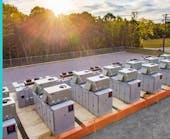Energy Innovation: Exploring Iron-Air and Zinc-Hybrid Batteries as Lithium-Ion Alternatives
For decades, lithium-ion batteries have reigned as the champion of battery and energy storage technologies. But, as the world progresses on its energy transition journey, this resource’s limitations and shortcomings are beginning to take center stage.
For example, according to the University of Washington’s Clean Energy Institute, most lithium-ion electrolytes are highly flammable and prone to overheating, increasing the risk of thermal runaway and combustion. These batteries are also only capable of holding a charge for several hours, and as the batteries age, they are known to lose capacity or fail.
In recent years, lithium-ion batteries have also been at the forefront of supply-chain issues. The raw materials needed to manufacture this technology are currently not produced in sufficient quantities to meet the ever-growing demand from multiple interested markets.
With demand only expected to increase, many have begun searching for viable alternatives to lithium-ion batteries.
Two such alternatives stepping up to the plate and gaining industry attention are iron-air and zinc-hybrid batteries.
Searching for a Solution
Dominion Energy recently announced a new battery storage pilot project aimed at increasing the length of time batteries can discharge electricity to the grid. To achieve this, Dominion will test the viability and feasibility of two lithium-ion battery alternatives – Form Energy’s iron-air battery and Eos Energy’s zinc-hybrid battery.
Iron-Air Batteries
Iron-air batteries are just that – batteries that operate using only low-cost iron, water, and air. According to Form Energy, these batteries are capable of storing electricity for up to 100 hours at 1/10th the cost of traditional lithium-ion technologies. Iron-air batteries are also devoid of any heavy metals and pose no risk of thermal runaway.
According to PBS, iron-air batteries work by taking advantage of rust. “When water, oxygen, and iron mix, they create rust. That reaction also releases energy. Iron-air batteries capture that energy and turn it into an electrical current – then recharge by reversing the reaction, ‘unrusting’ the iron and returning it to its metallic form.”
Iron-air batteries also come with the advantage of scalability. Each battery module is the size of a side-by-side washer and dryer set, and each module contains a stack of 50 one-meter-tall cells, which are filled with a water-based, non-flammable electrolyte. These modules are grouped together in a protected enclosure, and these enclosures are then grouped together to form megawatt-scale power blocks that can connect directly to the electricity grid.
Zinc-Hybrid Batteries
Much like its iron-air counterpart, zinc-hybrid batteries utilize abundant, inexpensive, and nonflammable materials.
To start, zinc-hybrid batteries use electricity from the grid to split zincate into zinc, water, and oxygen. This splitting charges the zinc particles, which can store electricity for weeks at a time. When electricity is needed, the charged zinc is combined with oxygen which simultaneously releases the stored electricity and produces more zincate. This zincate is recycled and used to begin the process over again.
The battery is comprised of three parts:
- Zinc Regenerator – Generates charged zinc particles.
- Storage Tank – Holds the potassium hydroxide electrolyte and charged zinc.
- Power Stack – A fuel cell that turns the zinc back to zincate and delivers the charge back to the grid.
It’s this potassium hydroxide electrolyte that helps provide many of the beneficial features synonymous with zinc-hybrid batteries. For instance, zinc can be stored for months in the electrolyte while only experiencing a 1% loss of stored charge per day. The electrolyte doesn’t degrade, and there is no net consumption of zinc, oxygen, or water.
Finally, the potassium electrolyte doesn’t utilize the traditional flammable mixture of lithium salts and organic solvents that lithium-ion batteries do, negating the risk of ignition or explosion and creating an extremely stable substance.
While current figures have the round-trip efficiency of the system at only 65% (compared to lithium-ion’s 95%), Eos Energy claims its system can successfully provide 70 to 100 hours of storage.
Progressing the Path Towards Net Zero
While these technologies have a way to go before dethroning lithium-ion as the battery of choice, this testing will help solidify the feasibility, safety, and performance ability of these alternatives. Through innovation and experimentation, the industry can find a path forward on its net-zero journey in a safer, more efficient, and more environmentally friendly manner.





